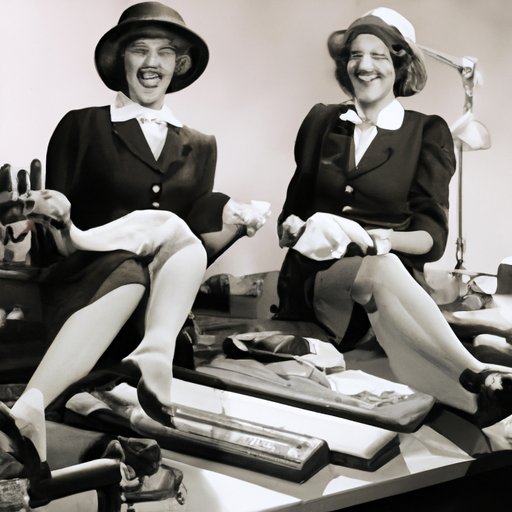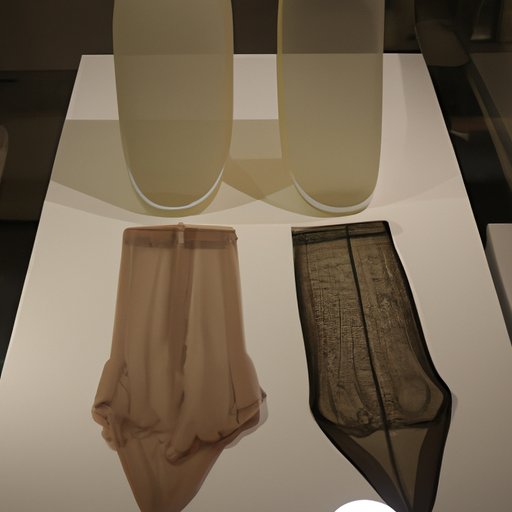Introduction
Panty hose, or hosiery, are garments made from sheer fabric that cover the legs and feet. They are typically worn underneath dresses, skirts, and other clothing items for warmth or to improve the appearance of an outfit. Panty hose have been around for decades and have had a significant impact on women’s fashion throughout history. How did panty hose come to be? When were they invented? This article will explore these questions and more to provide a better understanding of the history of panty hose.

A Historical Analysis of the Invention and Evolution of Panty Hose
The first attempts at creating hosiery can be traced back to ancient civilizations. For example, the Ancient Egyptians used linen and animal skins to create leggings to protect their legs from the elements. Over time, hosiery evolved to become more fashionable and was made using different materials such as silk and cotton. However, it wasn’t until the 1950s that panty hose were invented.
In 1958, Allen Gant Jr., a North Carolina-based hosiery manufacturer, invented the first pair of panty hose. He created them after noticing that his wife was having trouble finding stockings that fit her properly. He then decided to combine the top part of a girdle with the bottom part of a stocking to make the first pair of panty hose. The new product was an instant success and quickly gained popularity among women of all ages.
Since their invention, panty hose have undergone several changes. For example, they now come in a variety of colors, fabrics, styles, and sizes. Additionally, they are often made with special features such as reinforced toes, control tops, and anti-bacterial treatments. Panty hose have also become more affordable, allowing more people to buy and wear them.
Exploring the Cultural Significance of Panty Hose Throughout History
Since their invention, panty hose have had a major impact on women’s fashion. Before their invention, stockings were typically held up by garters, which could be uncomfortable and inconvenient. Panty hose eliminated the need for garters and allowed women to move freely without worrying about their stockings falling down. They also provided a more streamlined look, which was perfect for the sleek and sophisticated fashion trends of the 1960s and 1970s.
Furthermore, panty hose changed the way women dressed for work. They allowed women to look professional and put together without sacrificing comfort. Prior to their invention, women often wore long skirts and dresses to the office, which could be cumbersome and impractical. Panty hose allowed women to wear shorter skirts and still look appropriate and professional.
How Panty Hose Changed Women’s Fashion in the 20th Century
In the 1980s, panty hose became a fashion staple. This was due in part to the growing trend of wearing shorts and skirts in everyday life. As shorts and skirts became more popular, women needed something to cover their legs and feet. Panty hose were the perfect solution because they were comfortable, stylish, and easy to wear. Additionally, panty hose allowed women to show off their legs without having to worry about being too revealing.
Panty hose also became a symbol of status and luxury. In the 1980s, many designers released high-end hosiery lines that featured intricate designs and luxurious fabrics. These expensive pairs of panty hose were seen as a sign of wealth and sophistication, and they quickly became must-have items for fashion-forward women.

The Innovative Inventors Who Pioneered Panty Hose
The invention of panty hose is largely attributed to Allen Gant Jr., but there were other innovators behind this revolutionary product. For instance, Frederick Mellinger, founder of Frederick’s of Hollywood, was one of the first to offer panty hose in a variety of colors and styles. He was also responsible for introducing the world to fishnet stockings, which became a popular fashion trend in the 1960s.
Additionally, Dale McClure and Stephanie Krieger were two of the first female inventors to develop panty hose. In 1965, the duo created the “Knee Highs” line of panty hose, which featured reinforced toes and heels for added durability. Their invention revolutionized the hosiery industry and sparked a wave of innovation that continues to this day.

A Timeline of Panty Hose: From Invention to Popularity
1958: Allen Gant Jr. invents the first pair of panty hose.
1965: Dale McClure and Stephanie Krieger create the “Knee Highs” line of panty hose.
1970s: Panty hose become increasingly popular, with many designers releasing high-end hosiery lines.
1980s: Panty hose become a fashion staple, with shorts and skirts becoming more popular.
1990s: Sheer panty hose become a must-have item, with many women wearing them on a daily basis.
2000s: Panty hose continue to evolve, with new fabrics and designs being introduced.
Conclusion
Panty hose have come a long way since their invention in 1958. They have changed the way women dress and impacted fashion trends throughout history. From the early days of hosiery to the modern era of sheer panty hose, it’s clear that panty hose have had a major influence on women’s fashion. The innovative inventors behind this revolutionary product have helped to shape fashion history and will continue to do so for years to come.
(Note: Is this article not meeting your expectations? Do you have knowledge or insights to share? Unlock new opportunities and expand your reach by joining our authors team. Click Registration to join us and share your expertise with our readers.)
